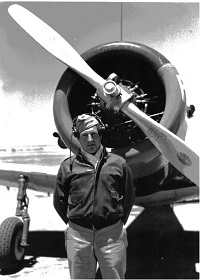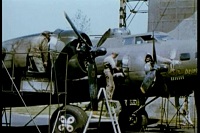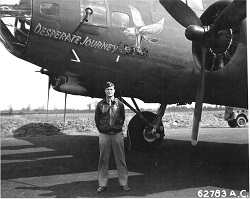Wayne
was born Feb 15, 1916 in Douglas township in Ida County, Iowa.
His parents were Roy Burton and Lulu Mabel (Fogleman
) Buck. The family moved to Cherokee County and farmed south of Washta.
W. Buck
Builds Hangar For Plane
Construction of a new hangar at the municipal airport has been started
by Wayne Buck, young Washta airman, who will keep his newly purchased
airplane at the local field. Permission to build the hangar was given
by the city recently. Buck is paying for the work and materials and the
project is costing the city nothing, councilmen said. The new hangar is
located a little east of where the old one used to be. It is of
galvanized metal construction. (Source: Cherokee Daily Times, Oct 9,
1940, pg. 6)
On Friday, December 13, 1940,
the Cherokee Daily Times reported "Wayne Buck of Washta purchases new
$1750 plane."
SEVERAL PLANES HERE ARE GROUNDED
Private airplanes owned by Cherokee county fliers are grounded under
government war time orders.
There
are several in the Cherokee vicinity. Two are located at the municipal
airport, owned by Wayne Buck of Washta and Ellsworth Allen of Cherokee.
Ed Runyan of Cherokee also has a plane. Two dismantled planes are owned
by Orlow Cooper of Cherokee. Another private plane is located on the
Ray Miller farm near Larrabee and Lawrence Flinders has a ship at his
farm northeast of Larabee. The McMann brothers, just over the line and
near Sutherland have a plane. (Source: Cherokee Daily Times, Cherokee,
IA., Dec 8, 1941, pg. 1)
ENLISTS IN
SERVICE
Wayne enlisted
in the service at Fort Des Moines, Iowa, January 23, 1942.
WAYNE L. BUCK IS AVIATION CADET
Wayne L. Buck, son of Mr and Mrs. Roy B. Buck, who live near Washta,
has enrolled as an aviation cadet in the air corps basic flying school
at Gardner Field, Taft, Calif. Buck for some time kept an airplane in a
hangar he erected at the Cherokee municipal airport. He is well-known
here. Upon successful completion of the course, Buck will receive a
commission as second lieutenant in the air corps reserve. (Source: Cherokee Daily Times, Jul 31,
1942, pg. 1)
FOUR IOWANS REPORTED MISSING IN
ACTION
Washington, D. C. Four Iowans were reported missing in action in the
European area Saturday by the war department. Those missing were Second
Lt. Wayne L. Buck, Washta; First Lt. Norbert D. Koll, Mapleton; Tech.
Sgt. James V. Shaw, Estherville; and Staff Sgt Willard O. Simpson, Des
Moines.
(Source: The Courier, Waterloo, IA, 13 Jun 1943, pg. 2)
FATE OF LT. WAYNE BUCK, LOST IN
ACTION, IS STILL IN DOUBT
Brother on Visit Here Reports No Definite Word
The
fate of Lt. Wayne Buck, 28, who was reported missing in action over
Europe early last year, is still in doubt, his brother, Aviation
Student Virgil Buck, disclosed here Wednesday morning. A/S Buck, who
arrived here Wednesday morning after a 43 hour trip by train from
Turner Field, Ga., to spend a short furlough with friends in Cherokee
and his family at Washta, said it hs not been definitely established
whether his brother was killed, wounded or taken prisoner after his
bomber was shot down.
He said he had written a letter to his brother
which traveled around the world and many weeks later returned to him
bearing an official stamp saying "casualty status verified." In
military terms, a "casualty" is any serviceman killed, missing or
wounded.
Lt. Buck's co-pilot was a Mapleton flier who apparently
lost his life. News reports some time ago told of a medal having been
presented to his parents at Mapleton.
Lt. Buck had his own airplane
before entering service and kept it in a hangar at the Cherokee
municipal airport. He was an enthusiastic private flier and ferried a
number of planes from Kansas City, Mo., to Sioux City for the Beacon
Airways. His own plane was a new machine purchased at Kansas City.
"Wayne Would Make It"
"If
there was any way out of it, Wayne would have made it," his brother
asserted, adding that there is a probability that he might have been
taken under cover by the French underground which has helped countless
allied fliers to escape. Since we haven't received any official word
except that he is missing, we still have hopes that Wayne will come
back."
A/S Buck worked for Hotel Lewis in 1937 and later sold
insurance before going into service. His father is a prominent turkey
producer living south of Washta. The family recently moved to the old
Noble farm south of that town.
"Dad still raises turkeys", he said.
"When they moved he was going to quit, but later decided he'd be too
lonesome if he did so he's still raising them".
(Source: The Cherokee
Daily Times, Cherokee, IA, Mar 8, 1944, pg. 1)
Buck,
Wayne Leroy
Second Lieutenant, 324th Bomb Squadron, 91st
Bomb Group, 8th Air Force,
World War II.
The 91st Bomb Group (Heavy) was an air combat
unit of the United States Army Air Force during WW II. Classified as
a heavy bombardment group, the 91st operated B-17 Flying Fortress
aircraft and was known unofficially as "The Ragged Irregulars or as
"Wray's
Ragged Irregulars", after the commander who took the group to
England.
The 91st Bomb Group conducted 340 bombing missions with the 8th Air
Force over Europe, operating out of the RAF Bassingbourn Air Force
Station located in Cambridgeshire, England.
The 91st Bomb Group is most noted as the unit that suffered the
greatest number of losses of any heavy bomb group during WW II.
The Eighth Air Force flew a total of 264,618
individual bomber sorties
out of England during World War II. The 91st Bomb Group (Heavy), alone,
flew 340 missions. Although many missions were routine, with little
action, all too many were anything but routine. Formations often were
subjected to continuous German fighter attacks, especially during the
early months of the war. Anti-aircraft batteries sent up clouds of flak
over most targets. Losses of planes and lives were severe. Many of the
returning planes were so badly damaged that they barely were able to
struggle back to their bases in England. Causalities among the crews
were heavy. Even the ""milk runs"" were far from uneventful. Assembling
the complex formations in the murky skies over England and flying the
long distances at subzero temperatures to and from the target in aging,
war weary planes was wrought with danger. Each mission presented its
own unique drama about which any number of stories could be told.
(Source: "Mary Ruth"
Memories of Mobile...We Still
Remember Stories from the 91st Bomb Group by Lowell L Getz) |
Operations - The 91st received orders to
deploy overseas and they moved
by squadrons to the United Kingdom, beginning with the 324th Bomb
Squadron on 25 September 1942. The 91st was was one of four groups
earmarked for the 12th Air Force in support of Operation Torch
and were sent to England to acquire combat experience to move to North
Africa.
The first phase (Nov 4 1942 - May 1, 1943) of the combat history of the 91st Bomb Group involved developing operational experience as one of the four "pioneer"
B-17 groups, creating doctrine and tactics.
During the first phase, they also pioneered the concept of strategic
bombing by daylight.
The 91st was made a part of the 101st
Provisional Bomb Wing on Jan 3,
1943. Its first mission to a target in Germany occurred Jan 27 and it
earned the first of two Distinguished Unit Citations on Mar 4 when it
continued an attack against the marshalling yards at Hamm,
Germany after all the other groups had turned back because of
poor weather conditions.
On April 17, 1943, the group led the Eighth Air Force on its first mission
against the German aircraft industry, attacking Bremen.
German fighter reaction was intense and sustained and the Eighth
lost twice as many bombers as on any previous mission. The 91st had six
B-17s shot down, all from the 401st Bomb Squadron.
The second phase of combat operations began in May 1943. The 91st was placed in a leadership role at a time when the expanding Bomber Command struggled to
establish air superiority without adequate fighter support. The Eighth's mission was to develop, during the next three months, into a force
of sixteen B-17
groups to began attacking industrial targets deep inside Germany.
On May 21, 1943, B-17 Flying Fortress #42-3053,
nicknamed "Desperate
Journey." was shot
down by enemy fighters while on mission to Wilhelmshaven, Germany. It went down near Wittmund, Germany. Co-pilot
and Second Lieutenant Wayne Buck was one of eight members of the 10-man
crew that were killed. Two survived and became POWs. Missing Air Crew
Report
№ 4438 and 4633.
The crew members Killed In Action were:
1st Lt. Norbert D Koll, IA, O-726258, Pilot
2nd Lt. Wayne L Buck, IA, O-729806, Co-Pilot
2nd Lt. Edwin M Bruton Jr, MO, O-731017, Bombardier
T/Sgt. Alfredo L Davila, TX, 38093722, Radio Operator/Gunner
T/Sgt. Albert W Zaverl, CO, 18047296, Flight Engineer/Top Turret Gunner
S/Sgt. William L Caligan Jr, CT, 11045589, Tail Gunner
Sgt. Elwyn J Roberts, PA, 13025136, Right Waist Gunner
S/Sgt. Guy F Wyatt, IN, 35358470, Left Waist Gunner |
Combat History - Approximately 5,200 crewmen flew combat missions for the 91st from 1942
to 1945. 19% were killed or missing. Of the 35 original crews to arrive
at Bassingbourn, 17 were lost in combat (47%) During the first six
months of operations, 22 of 46 listed crews were lost. The fatalities
in
the 91st Bomb Group, equivalent to an infantry regiment in numbers of
combat personnel exceeded the killed in action of more than half of the
Army's ground force division and equaled or exceeded the rate of killed
in action in the infantry regiments. Only seven division (all infantry)
had killed in action rates higher than the 91st BG. (Other sources than those already listed above include websites: Wikipedia, 91st Bombardment Group; Time line of WWII (1943); Eighth Air Force; Heroes of freedom;)
|
Click on
images to enlarge
|

Margaret
Stoeber & Wayne Buck were engaged to be married.
It is
believed this photo was taken shortly before Wayne left for
England.
(Courtesy
of James Schumacher)
|

|
 |
The
photo of Wayne above was the possession of his fiance, Margaret
(Stoeber) Schumacher. The handwritten note, probably written by
Margaret,
was found on the back of the photo.
(Courtesy
of James Schumacher) |

Maintenance on the Desperate Journey at
Bassingbourn.
Wayne was co-pilot of this B-17 aircraft nicknamed "Desperate Journey"
when it was shot down on May 21, 1943.
(image source: heroes of freedom/planes
website)

The man in the photo is
Major
Aycock, Commanding Officer of the 324th Bomb Sq., 91st Bomb Group, 8th
Air Force, Poses beside the Boeing B-17 "Flying Fortress" 'Desperate
Journey'. The photo was taken in England, 14 April 1943.
"Desperate Journey" was shot down a little over a
month later.
(Source: Air Museum of Britain)
|
2nd Lt. Wayne L. Buck died at the age of 27 years old while serving his country during WW II.
|
|




